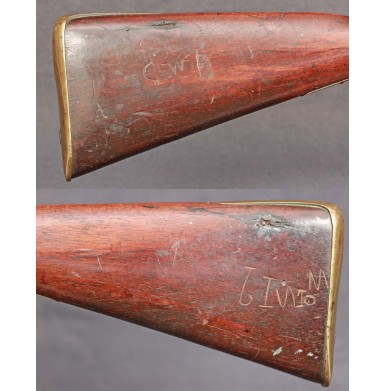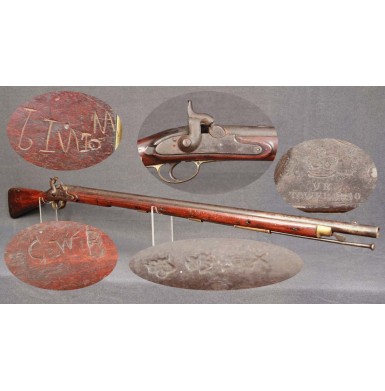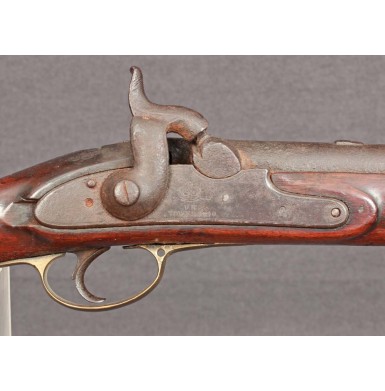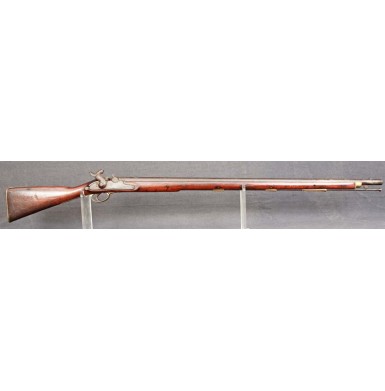While the Pattern 1853 “Long” Enfield Rifle Musket is the English long arm that immediately comes to mind when discussing the guns imported by the Confederacy during the American Civil War, the South also imported thousands of older, obsolete arms during the first 12-18 months of the conflict. On February 3, 1863, the head of the Confederate Ordnance Department, Josiah Gorgas, released a summary of arms and equipment purchased and imported from the beginning of the war through the end of 1862. Some “21,040 British Muskets” are included within that summary statement. Research has determined that this number of “British Muskets’ was primarily comprised of obsolete British P-1839 and P-1842 percussion muskets, as well as slightly more modern P-1851 Mini” Rifles. Documents and invoices within the McRae papers suggest that the breakdown was 9,400 P-1839 and P-1842 muskets (with no further classification possible) and 11,640 P-1851 Mini” Rifles. One receipt from J.E. Barnett & Sons (London), dated July 3, 1862 documents the shipment of 8,260 smoothbore muskets from Liverpool, bound for the Confederacy. The arms appear to be part of a lot of some 30,000 “obsolete & defective muskets & rifles” that were purchased by Barnett from the British Ordnance Department in the fall of 1860. The sale of other obsolete arms to the Confederacy by Barnett (typically through S. Isaac, Campbell & Company) is well documented in the McRae papers, and includes P-1851 Mini” Rifles, Brunswick pattern rifles and various patterns of smoothbore muskets. Some of these guns bear the mark of known Confederate viewers (arms inspectors) Curtis & Hughes, who marked them with a small CH /1 within a circle on the top of the comb of the buttstock, forward of the buttplate tang. While not all of the obsolete arms sold to the Confederacy by Barnett bear this mark, the Barnett retailed arms do have some similar characteristics. The guns were typically refurbished in some manner, as many were not in working condition when Barnett purchased them. Re-used and re-proved barrels are common, resulting in guns with a mixture of older British Ordnance Department marks and commercial London proofs. The guns sometimes have non-standard features, the result of upgrade and repairs, and sometimes show newly applied mating marks, as parts from multiple sources were fit together and reassembled. Barnett would then sell the guns to S. Isaac, Campbell & Company, who would sell them to Confederate purchasing agent Caleb Huse. The above referenced Barnett invoice notes the smoothbore muskets being sold at a price of 26 schillings, and SIC invoices show the same arms being sold to Huse for 31 schillings. Another invoice shows that Huse was purchasing obsolete muskets from SIC as early as late November, 1861. The majority of these smooth bore arms appear to have shipped via the blockade runner Gladiator, but at least 200 were shipped via the ill fated Stephen Hart, which was captured during its run, with its cargo being sold at a Prize Court auction at the Brooklyn Naval Yard on May 22, 1862. Included in that cargo were 10 cases (containing 20 guns each) of “British smoothbore muskets with triangular bayonets, 75-100 bore”. The guns sold at the auction for $4.00 each. Clearly large number of the obsolete smoothbore guns made it into South and the Confederate Ordnance system. The list of Confederate Ordnance supplies moved from Demopolis, AL to Columbus, GA in February of 1864 listed “3,398 Tower muskets, caliber .75”. These would have been a mixture of British P-1839 and P-1842 muskets.
The Pattern 1839 Musket was the first percussion infantry long arm to be widely issued by the British military. For all practical purposes the gun was a modernized India Pattern (aka "3rd model") Brown Bess musket, a gun that had been in use within the British military since 1793 (Type I). The Type II, adopted in 1809, remained the standard infantry service long arm until the adoption of the P-1839. The small number of George Lovell’s P-1838 percussion muskets that were produced can rightfully lay claim to the moniker of the first percussion British infantry arms, but they were produced in such small numbers as to be considered experimental at best. The P-1839 was a conscious effort on the part of the British Board of Ordnance to adopt a percussion musket and to simultaneously use up the large supply of India Pattern parts on hand. In fact, the first 30,000 P-1839 muskets to be assembled (“set up” as the British would call it) were originally to be 30,000 newly assembled India Pattern flintlocks, but it was decided that they should instead be assembled as percussion guns. Like its predecessor, the P-1839 musket was nominally 55” in overall length, with a 39” smoothbore barrel of approximately .75 (.76 according to the British) caliber. The musket did not have barrel bands, rather the barrel was retained in the fashion of the earlier flintlocks, with three round pins through the stock, the screw for the upper swivel and a single breech pin (tang screw). The ramrod was held by three brass pipes that were pinned to the stock, in much the same manner as the ones used on India Pattern muskets. The P-1839 musket had a conventional front action percussion lock (the P-1838 Lovell design used a back action lock) and many of the early guns utilized surplus flintlock lock plates with the additional holes for the frizzen and frizzen spring screw being filled. The lock was secured by a pair of screws that entered through an S-shaped, convex side plate, which was secured to the stock flat by a wood screw in its center. These modified locks, taken together with the India Pattern styling and pinned barrel assembly, is no doubt the reason for numerous early to mid war Confederate accounts that mention troops being issued “old Tower muskets, altered to percussion”. These reports are almost certainly references to misidentified P-1839 percussion muskets. Initially the Pattern 1839 was manufactured with a hook shaped, Hanoverian style bayonet catch under the muzzle, but in late 1844 this was replaced by the Lovell’s pattern catch, which remained in use on British muskets until the adoption of the P-1853 “Enfield”. The P-1839 was quickly superseded by the Pattern 1842 musket, which was quite similar but dispensed with the serpentine side plate, utilized newly made percussion locks, introduced Lovell’s “side nail cups’ (lock screw washers) and replaced the round pins with wedges to secure the barrel. Even so, the P-1839 remained in production through 1851 and continued to see service, even in the Crimean War, by which point it had been rendered totally obsolete by the P-1853 rifle musket.
This particular P-1839 Percussion Musket is a classic example of one of the obsolete, reconditioned smoothbore arms sold to the Confederacy by Barnett, through S. Isaac, Campbell & Company. The gun has been “modernized” by upgrading the barrel retention pins to flat keys, as found on the P-1842. The gun bears the classic combination of British military and London commercial proof marks that are found on these rehabilitated and Barnett retailed muskets. The breech is marked with a (CROWN) / GR / (BROAD ARROW), a (CROWN) / MR and with a London commercial proof mark as well. The gun shows a second set of assembly marks, applied over the original assembly marks, from the re-building of the musket. The original assembly mark of \/ is present on the bottom edge of the lock, the bottom of the barrel and in the ramrod channel. This mark has been over struck with the assembly mark | | | | on the bottom edge of the lock and the bottom of the barrel. The new mark is also in the ramrod channel between the two upper pipes, with the original mark remaining in the channel, closer to where the ramrod enters the stock, near the triggerguard. Even more importantly to tie the gun directly to the Confederacy, the gun bears a set of initials and a partial name carved into the buttstock. The partial name is almost certainly identifiable as that of a member of the 1st Chickasaw-Choctaw Mounted Rifles, serving the Confederacy in the Indian Territory of the Trans-Mississippi Theater. The reverse buttstock is carved in a crude, period hand J INTO (SYMBOL). The “J” is backwards, as is the “N”. The last character, slightly above the “J INTO” appears at first glance to be an “M”, but is probably a pictogram for mountains, as a Native American named John Into Lair served with the 1st Chickasaw-Choctaw Mounted Rifles. No other regiment on either side had any soldier who served with any combination of names that makes the “J INTO” make any kind of sense. The 1st Chickasaw-Choctaw Mounted Rifles was organized at Scullyville in the Choctaw Nation in July of 1861 and served in the Trans-Mississippi throughout the entire war, surrendering on June 23, 1865. The regiment was comprised of six companies of Choctaws, three companies of Chickasaws, and one company of half-breeds, and served in Cooper’s and later Walker’s Brigades during the war.
This Confederate used P-1839 Musket is in about VERY GOOD ATTIC (as found) condition. The lock of the musket is marked with a (CROWN) / VR / TOWER 1840 forward of the hammer, and also bears a partially legible small (CROWN) “ (BROAD ARROW) mark. The interior of the lock is marked 60, T, IM and with both a (CROWN) / 6 and a (CROWN) / 7 inspectors mark. The lock is mechanically functional and remains relatively crisp, and works as it should on every position. The lock plate and hammer have a thick brown patina, and the lock plate shows some light scattered pitting, with the hammer showing slightly heavier oxidation and moderate surface roughness. The barrel of the musket has a similar thick brown patina over most of its surface, with the patina thinning towards the muzzle and mixing with more pewter metal undertones. The barrel is mostly smooth, but like the lock shows light to moderate wear and surface roughness around the breech and bolster area, from the percussion cap flash. As previously noted the barrel bears both British military proofs and a London commercial proof. The bottom of the barrel is marked with a B / (BROAD ARROW), the initials J.T. and M, and with the name of the barrel maker CLIVE. The bore of the musket is in about FAIR condition and is dark, dirty and moderately pitted along its entire length. The muzzle shows a minor ding, which is very old, but would most likely have been cut away if from the period of the war, in order to keep the gun in service. A very old, period rear sight has been dovetailed into the barrel, and is worn down to only its base. It is not clear if this was a Barnett modification or one performed in the south. The rear portion of the breech plug tang is broken and missing, and appears to have been gone from the gun since the period of use. The gun retains its original Lovell’s patent bayonet catch under the muzzle, as well as the original “front sight” / bayonet lug. Both of the original sling swivels are missing and have been gone for a very long time. What appears to be the original button head iron ramrod is in place in the ramrod channel. The rod is about 1” short of full length, and the end that was originally threaded has been hammered into a crude screwdriver tip. The brass furniture of the musket has an uncleaned, golden mustard patina, and is very attractive. The stock of the musket is in about GOOD+ to NEAR VERY GOOD ATTIC condition. It shows a significant number of bumps, dings and even some chips and gouges, all the result of multiple decades of service and use. There is an old chip of wood missing from the rear of the lock mortise. The chip has been gone so long that the area is worn completely smooth. A pair of diagonal grain cracks are also present, running through the wrist area. These are stable, but should probably be attended to by a competent wood restoration specialist to keep them from becoming a structural issue. There is also an area of wood loss immediately to the rear of the percussion bolster. This appears to be from significant burn out from the percussion cap flash, which weakened the wood and ultimately allowed a small chunk to fall out. A pair of illegible (CROWN) / ““ (letters) marks are present in the belly of the stock, behind the triggerguard and a similarly illegible mark is present on the top of the stock, forward of the buttplate tang. A weak British Board of Ordnance ownership mark, a B O / (BROAD ARROW) is present on the obverse buttstock. The buttstock also bears the period carved initials C W B on the obverse and as noted above, J INTO M is carved into the reverse.
Overall this a really great looking, as found, attic condition P-1839 musket that was imported by the Confederacy. The gun is almost certainly identified to a Confederate Native American regiment and saw use in the most forgotten theater of the war. Any Confederate used musket is scarce, but one linked to an Indian unit in the Trans-Mississippi is incredibly scarce. This would be a great addition to any serious Confederate collection that focuses on import arms or the Trans-Mississippi. It displays well and has a great, untouched look. A small amount of information regarding John Into Lair and the 1st Chickasaw-Choctaw Mounted Rifles is include with the gun, and both the unit and the soldier are worthy of additional research. Further scholarship may reveal the identify of "CWB" as well.
SOLD






